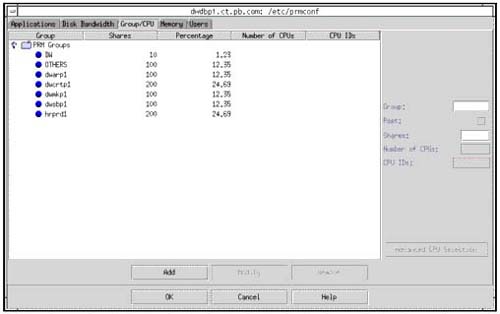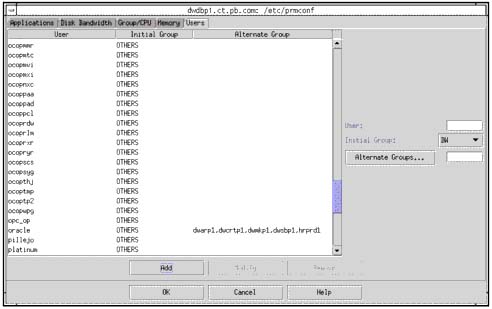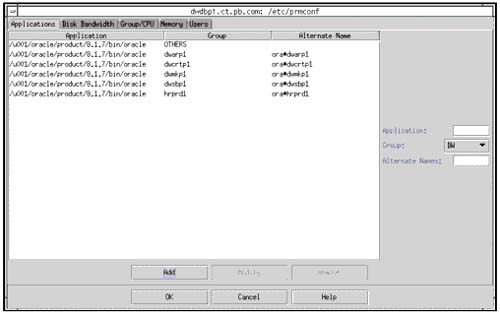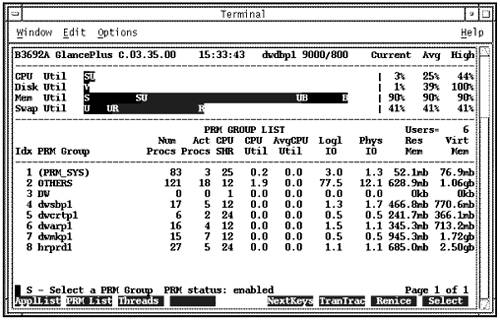PRM and Oracle Setup
| In this section we'll configure PRM on a system running five instances of Oracle. There are many processes running for each Oracle instance but there is a unique identifier for each instance that uses the ORACLE_SID environment variable. On the system used in this example the five Oracle instances are: dwsbp1, dwarp1, dwmkp1, hrprd1 and dwcrtp1 . We'll use these instance names during our configuration. The first step we'll perform using xprm , the graphical interface of PRM, is to create PRM groups and assign shares. We have only four CPUs in this Superdome nPartition so we'll use only FSS and not PSET PRM groups as shown in Figure 18-14: Figure 18-14. xprm Showing PRM Groups and FSS Shares Figure 18-14 shows that we have a total of seven PRM groups. The bottom five shown in the figure are Oracle database instances. Two of the seven groups are more important than the others, so we've assigned higher shares to those two groups. The DW group is not important, so we've assigned a small share to it. We haven't set up any Memory shares but that would be easy to do by selecting the Memory tab in the figure and assigned shares to the groups. Next we'll set up the users. The user oracle is already in the OTHERS group and we specify the Alternate Group for oracle as the five database instances, as shown in Figure 18-15: Figure 18-15. User oracle and Its Alternate Groups Next we'll define the applications and the corresponding PRM groups to which they'll be assigned. Figure 18-16 shows the Applications tab: Figure 18-16. xprm and Application We now have our five instances of Oracle set up such that the unique name for each instance will result in processes getting the assigned resources by the application manager. Figure 18-17 shows a summary of what we've configured in xprm : Figure 18-17. xprm for Oracle The figure shows that CPU and APPL have been Enabled . Now that we've performed the customization we want, we can apply the settings as shown Figure 18-18: Figure 18-18. xprm Load Configuration Now we can proceed to see that our configuration was loaded by running prmlist , as shown in the following abbreviated listing: root@dwdbp1[/etc] > prmlist PRM configured from file: /etc/prmconf File last modified: Fri May 24 15:20:42 2002 PRM Group PRMID CPU Entitlement ------------------------------------------------------- DW 2 1% OTHERS 1 11.11% dwarp1 5 11.11% dwcrtp1 4 22.22% dwmkp1 6 11.11% dwsbp1 3 11.11% hrprd1 7 22.22% PRM User Initial Group Alternate Group(s) -------------------------------------------------------------------------------- adm OTHERS bbuser OTHERS best1 OTHERS bh001pa OTHERS bin OTHERS certegy OTHERS cognos OTHERS ctrapp OTHERS daemon OTHERS db_hp OTHERS dbadict OTHERS ddbadcb OTHERS ddbajms OTHERS ddbarcl OTHERS . . . ocoptp2 OTHERS ocopwpg OTHERS opc_op OTHERS oracle OTHERS dwarp1,dwcrtp1,dwmkp1,dwsbp1 uucp OTHERS webadmin OTHERS www OTHERS zeke OTHERS PRM Application Assigned Group Alternate Name(s) -------------------------------------------------------------------------------- /u001/oracle/product/8.1.7/bin OTHERS /u001/oracle/product/8.1.7/bin dwarp1 ora*dwarp1 /u001/oracle/product/8.1.7/bin dwcrtp1 ora*dwcrtp1 /u001/oracle/product/8.1.7/bin dwmkp1 ora*dwmkp1 /u001/oracle/product/8.1.7/bin dwsbp1 ora*dwsbp1 /u001/oracle/product/8.1.7/bin hrprd1 ora*hrprd1 root@dwdbp1[/etc] > This listing shows the assigned groups and names at the end that we entered using xprm . Next we'll run Glance and look at the PRM Groups to see if they appear as shown in Figure 18-19: Figure 18-19. GlancePlus/UX Showing PRM Groups This screen shot shows the PRM Groups we set up as well as their respective shares with DW having the lowest share value. The only activity now taking place on the system is in OTHERS, which is the group to which root was moved from PRM_SYS . We can use prmmonitor to view PRM- related resources as well, as shown in the following abbreviated listing: [View full width]
The system is now ready for users. After Oracle users are on the system we can monitor activity and make adjustments to the shares as we see fit. All of the tasks performed in this Oracle section could have been performed manually as shown in the first section. Either way the same goal is accomplished with PRM providing control over the resources given to the individual instances of Oracle. |
EAN: 2147483647
Pages: 301





